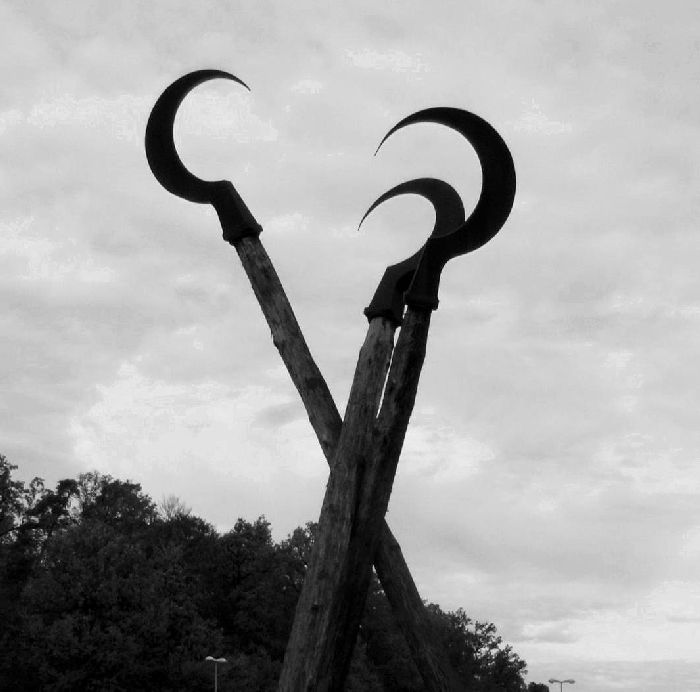Various Memorials on Patch Barracks in Stuttgart/Vaihingen
Pictures and text by Mark R. Hatlie
These pictures were taken on August 10, 2005, on Patch barracks in Stuttgart/Vaihingen, in southwest Germany.
Patch Barracks is the headquarters of United States forces in Europe, so it is a very officer-heavy military community. Despite the Stuttgart military community having grown much smaller over the past 15 years, Stuttgart remains important for coordinating American forces from Iceland to the Mediterrainian. Indeed, there is even some new construction going on.
These monuments are all very close together near the center of the base. They are interesting because of the variety of groups they encompass. They demonstrate that even within a relatively small and homogeneous community, where cultures of memory are no doubt important and tightly controlled, there is still wide descretion as to what is considered worthy of a monument and what and who is left out. It no doubt comes down to the personal initiative of individuals who undertake concrete steps - no pun intended - to have a monument put in place.
All the memorials have a relevance to the Stuttgart military community in that they focus on people from the community or conflicts that occurred since the community came into being. There are none for World War One or for the Pacific theater in World War Two, for example. But other than that, there is no system. There is no general Vietnam memorial, no Gulf War memorial, as yet no Iraq War or Enduring Freedom memorial. There is no framework for which groups are included in the memorial and which aren't - several extending to very broad "coverage". Again, it appears to be up to individuals or group constituencies to take the initiative and sponsor a memorial, and not the job of some official person to see to it that there is what I might call "commemorative symetry" on post.

|
There is a well-fortified but also well- kept and quite pleasant walkway near some of the office buildings. A small plaque in front of a bed of flowers indicates that the walkway has been made into a kind of memorial. Despite being such a small memorial, it tries to do justice to the whole possible spectrum of people who might pass along the walkway - anybody involved in the joint coordination of the services. |

|
It is dedicated to all World War Two veterans of the European Theater of all the services, even the Coast Guard. It was put up in the context of the 50th anniversary, but it is hard to know when that was. Probably 1995. Despite being cast in bronze, the memorial expends a few extra words to justify itself, without going into specifics: "For a variety of reasons..." Thus, it serves much the same function as the Tomb of the Unknown Soldier, a kind of catch-all memorial. But this one includes the living as well. |
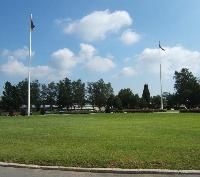
|
A short walk away, there is a wide open square, Washington Square, where the chapel and the main community building is located. This memorial barracks is still in use - indeed it is lived in, in a sense. But even in a narrower sense, this square is where the post has its flag raising and lowering every day. Don't get caught outdoors on post at 1700 or you will feel the social pressure to stop and stand at attention while the flag is lowered. |

|
At the center of the square, between the flags of the United States and the Federal Republic of Germany, there is a large plaque showing us why Patch Barracks is called Patch Barracks. |

|
There is no information about General Patch or what happened on June 2, 1945. Did he die in an accident like General Patton? Or did he retire or move to another command? How did he earn the honor of having such an important post named after him? He led the 7th Army for more than a year, but there were several armies. How was he special? We are left in the dark. |

|
Behind the flags, a little to the left of the American flag in the first picture above, there are two memorials right next to each other, a stone for prisoners of war and those missing in action from the Vietnam War and, behind it, a memorial to the victims of the terrorist attacks of September, 2001. |
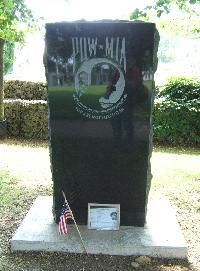
|
The POW/MIA monument is engraved with the image that is the official symbol of American POW/MIA commemoration, the sillouette of a figure with bowed head in front of a guard tower and barbed wire. |

|
No disrespect is intended by the inclusion of my reflection in the picture. |

|
The memorial has been visited by someone who put a framed picture of a veteran who went missing in 1968 at the base of the memorial stone. He or she framed the picture to last, but it has been there so long, subjected to wind and weather, that the frame is broken and nature and the elements are creeping in. |

|
The memorial to the victims of 911 is an interesting idea. The concrete slab is in the shape of the Pentagon, a reminder of one of the targets and an explicite emphasis on the Pentagon victims instead of on the Twin Towers. That is not surprising for a military community memorial. The plaque shows, however, that the memorial is inclusive, even extending explicitely to foreign nationals. On the other hand, they are listed separately from the American victims. The memorial is co-sponsored by the military and the Boy Scouts of America! |

|
It is hard to tell whether this monument is "in use". Were the benches intended for use? If so, they are placed in such a way that it would be hard to sit without putting your feet on the plaque. Or were they intended as symbols - empty seats, so to speak? I don't know. On at least the right hand bench, one of the planks is bent from use. |
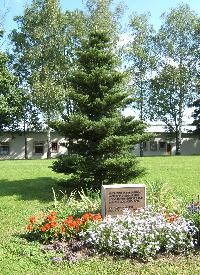
|
A few steps away, directly behind the Patch plaque, behind the row of cars, there is a memorial tree. |

|
It was "Planted in the spirit of German-American Friendship" in June of 1960 by the land of Baden-Wuerttemberg. |
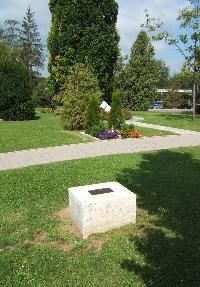
|
A few steps further along, to the left of the German flag in the Patch memorial picture above, right behind a bus stop by a walkway, there is a cluster of four memorials. Three of them are shown here - a memorial to Barbara Mooshake in the forground, a memorial to Christen A. Christensen Jr. in the middle, and, in the background, a Korean War memorial. The fourth memorial is to the right. It looks just like the Christensen memorial, except there is nothing on the stone. It is blank. But the stone is somewhat old and warn. It is hard to guess what that might mean. |

|
The memorial to Barbara Mooshake is a simple stone with a plaque. The stone appears to have been recently placed, so there are probably still people here on post who knew her. Just after I took the picture, I saw a kid walk up and read it, but his mother wasn't interested and they hurried on. |

|
The memorial gives no clue as to how she died. Interestingly the memorial appears to have been funded by a wide collection, as the sponsor is "the 6th ASG community". That includes anybody and everybody in the Stuttgart military community as well as other posts. |

|
The memorial to Christensen is similar. |

|
There is no hint as to how he died other than the date, when he was 55 years old. The dedicators are "friends" in his unit, but the memorial also bears the plaque of the American Legion. |

|
The Korean War memorial is interesting on a number of counts. For one, it is a sundial. I am not sure what that is supposed to symbolize. |

|
It is a very inclusive memorial, dedicated not to Americans, be they living or fallen, but to the "service of 22 nations". |

|
The other side bears the statement that "Freedom is not Free" with an outline of the Korean peninsula, including the armistice line drawn in, and the dates of the Korean conflict. |
